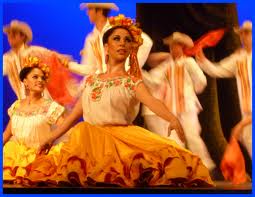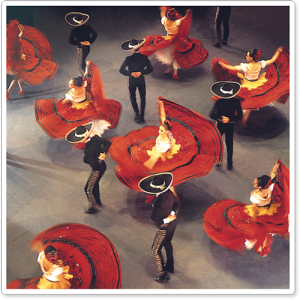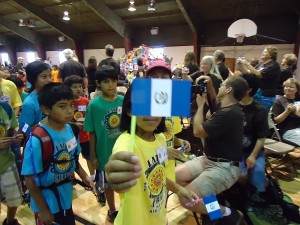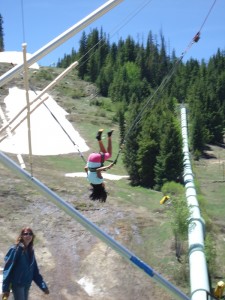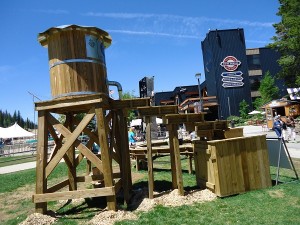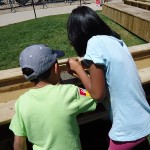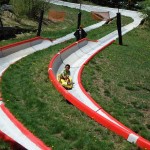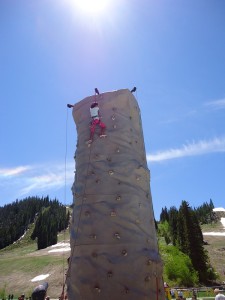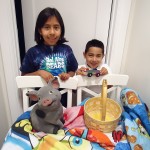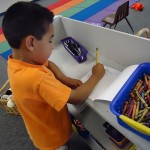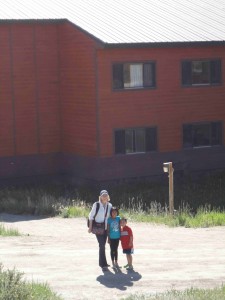Posts Tagged ‘Latin American Heritage Camp’
Latin American Heritage Camp
Monday, February 22nd, 2016Heritage Camp for Adoptive Families
Tuesday, July 2nd, 2013We just returned from six days in Colorado, the main purpose of which was to attend Heritage Camp for Adoptive Families. I love our life, but a part of me wishes we could live in that supportive, insulated world forever. This is our fifth year attending, over the past six years: The first time I flew alone from California with Olivia, when she had just turned five, and from the moment we walked together into the big gathering hall filled with more than 100 adoptive families with kids born in Latin America, we looked at each other with disbelieving eyes. Was this place real? Even at five years old, Olivia, perhaps more than me, sensed we had discovered something special.
I’ll try to put into words why I love Heritage Camp. It’s the feeling of being at home, among friends, among families who also get stared at, everywhere else they go. Of not needing to explain anything to anyone. Of our family being in a large social situation, and in a very deep and rare way, feeling relaxed. It’s watching the teen counselors, most of whom are camp alumni, as they interact with our children–so caring and empathic because the teens are also adopted, with parents and other family members who don’t look like them, and they’ve already endured years of that, and have come out the other side, which gives me hope my children will, too. Of dancing at the Fiesta on Saturday night and realizing every child on the dance floor is adopted, not only mine, and what a relief that must feel like to my kids–for once, being like everybody else. Of listening to a roundtable discussion by a panel of adult adoptees, and learning from their experiences about ways I can try to do better. About ways we can all learn from each other.
I sometimes feel like a broken record, the way I constantly promote Heritage Camp, Heritage Camp, Heritage Camp! But then at dinner our first night, I asked an attendee from Illinois who was sitting at my table how she’d learned about Heritage Camp, and she said, “I read about it on a blog I follow, Mamalita.” Even better, she told me she definitely planned to return next year.
So I’ll say it again. If you haven’t ever attended Heritage Camp for Adoptive Families, think about it. That’s all. Think about it.
Thank you. ~
A spectacular spectacle
Tuesday, November 27th, 2012Over Veterans’ Day weekend, friends we met through Latin American Heritage Camp came to visit. And because their daughter, like our daughter, studies ballet, I bought tickets for four of us–the two girls, the other mother, and me–to a performance by Ballet Folklorico de Mexico de Amalia Hernandez. For years, I’ve heard about this company, and now that I’ve finally seen them, I can say, without reservation, if they ever come to your town, or anywhere close, run, don’t walk, to the box office to buy yourself a ticket.
The costumes! The music! The passion! The pageantry! All absolutely fabulous.
The program notes state that Ballet Folklorico was founded by Amalia Hernandez in 1952, and numbers 76 dancers. Hernandez’s goal in starting the company was to preserve the folk dances of Mexico. That she has done, and then some. Every piece was more intricate and involved than the one previous, and just when I thought the choreography and costumes could never top themselves, out would parade a line of mariachis, or a few dozen people decked in quetzal headdresses, or a man lassoing a rope over his head in a breathtakingly display of skill and arm strength.
The girls loved it!
My only complaint–and it’s not a complaint, really, but an observation–is that the floor of the venue stage–in this case, the Marin County Civic Center–was covered with a thick rubber mat. Alas, this is common in performance spaces, but I know from my years of tap-dancing that a wooden floor is what the intricate footwork of Ballet Folklorico cries out for. Rubber deadens the rat-a-tat-tat of the heel drops, turning them into dull thuds.
But this is a small quibble. Ballet Folklorico is a must-see, especially for families like ours. Go!
Latin American Heritage Camp
Monday, June 27th, 2011I’m sitting in Chicago’s O’Hare Airport, en route to Iowa for my reading at Prairie Lights books on Tuesday, June 28 at 7 p.m.
Tim and the kids have returned to California after our family participated in our fourth annual Latin American Heritage Camp. As Olivia said, I wish it didn’t have to end.
Because I’m about to board the plane to Cedar Rapids, I’ll copy here what I posted about the camp on my Mamalita Facebook page.
I realized this week why I believe in Heritage Camp. It’s not so much the “heritage” as it is the shared adoption experience. To hear the high school students speak about the meaningful, unique, essential friendships they formed as preschoolers –and continue as teens–convinces me that this experience is vital. I hope for the same, for our children.
Got to go catch my flight. To be continued…
A summer day at Winter Park
Thursday, June 23rd, 2011That’s Winter Park, Colorado, a few miles down the road from Latin American Heritage Camp, where we are headed for our fourth year of family camp for adoptive families.
The “assay station” made a big impression. Panning for gold makes more sense after you’ve screened for your own gems. Olivia and Mateo also conquered the Alpine slide, bungee jump, zip line, miniature golf, rock wall, and the maze. Last night, the best night’s sleep ever.
In the photo above, Olivia has scaled the climbing wall, and is ringing the bell to signify her victory. Not seen in the frame is me, on a bench, white-knuckling the camera and holding my breath.
Summer Vacation
Monday, June 20th, 2011No lunches to make, no bus to run for, no shoes to find, no totes to pack. The kids are sleeping late.
Yes, today is the first Monday of summer vacation.
Last night, Olivia and Mateo rode bikes and scooters until dark while Tim and I shot hoops–as in basketball. When’s the last time we did that?
This week, we head for Colorado and Heritage Camp, where Mamalita is the book club selection–available on Kindle and Nook for easy downloading–and then I go to the fabulous Prairie Lights Bookstore in Iowa City to read on Tuesday, June 28 at 7 p.m. My friend, Gretchen B. Wright, will meet me there–Gretchen and I met at a writing workshop at Lake Atitlan, Guatemala–as will other friends through adoption.
But first, a few photos. The playground at Mateo’s school, alive with students and teachers dancing to the Slumdog Millionaire anthem, Jai Ho. Olivia and Mateo presenting Tim with his Father’s Day gift, a miniature skateboard handmade by Mateo in a woodshop class, against a backdrop of their own design. And finally, Mateo drawing during his last day as a kindergartener.
Another year, gone.
Guatemala Part 7: Spanish School redux
Monday, February 28th, 2011Several people have asked if I recommend studying Spanish in Guatemala. Absolutely, yes. Language schools exist throughout the country, but we only have studied in Antigua. Last August, we spent a month in Guatemala and I posted a blog about our experience at one school, San Jose El Viejo. I’m reposting the blog here.
This summer at Latin American Heritage Camp, a panel of teen and adult adoptees dedicated a large percentage of their discussion to the importance of learning, speaking, and/or retaining the language of one’s birth country. The consensus was that language is critical if one wishes to interface with birth family, foster family, orphanage family, or, indeed, the culture at large, in a meaningful way. That’s true in my own life, as well: Speaking even elementary Spanish has allowed me to communicate with many more people in Guatemala than I would be able to otherwise.
Not that teaching a child a second language is easy. For my husband and me, it has been anything but that. Neither of us is fluent in Spanish, which is our biggest obstacle. And not only do we not employ a nanny who speaks Spanish, we rarely, if ever, hire a babysitter. Our local public school is not bilingual, and though we have a few Spanish-speaking friends, their children prefer to speak English while playing with our kids. This year, in third grade, Olivia will study Spanish. We’re lucky that it’s the second language taught in California schools. What about the kids adopted from Nepal or Russia or Ethiopia? How do they learn to communicate with others from their homeland?
The good news is that during this past trip to Guatemala, Olivia saw and understood the benefits of speaking Spanish. While listening to one conversation I carried on with someone, she said with admiration, “Mom, you speak a lot of Spanish!” Reader, believe me, I don’t. But you get the idea: In a real-life example, my daughter realized the efficacy of learning a second language. You can talk to people who don’t speak English!
Guatemala is renowned for its language schools. Here is link to a list of some of them. For the last weeks we were there, I managed to convince Olivia to attend morning classes while I posted my blog. She agreed that learning new vocabulary while drawing pictures and making figures with clay was a lot more fun than watching me wrestle with my USB flash drive at Conexion. The photo above is of her with her maestra.
For anyone who is considering Spanish school, I say “go.” Olivia attended San Jose El Viejo–because it was closest to our apartment and because the children of a woman I met through an adoption listserve were attending—and loved it. But I don’t think you can go wrong with any of them.
I’m not deluding myself into believing that Olivia speaks Spanish, or will retain any of the information that she learned. Now that she’s visited Guatemala, though, and attended school, she sees that speaking Spanish is an attainable goal, and one that multiplies her opportunities to communicate. That one outcome, to me, makes the entire trip worthwhile.
Cultural awareness and Guatemala news
Tuesday, January 11th, 2011As an adoptive parent to two children born in Guatemala, I’m often asked how I keep our children’s culture alive. After first repeating how important culture-keeping is for our family, I list some of what we do: Study Spanish, collect and study Guatemalan arts and crafts, follow Guatemalan politics and current events, listen to Latin music, eat Central American food, attend culture camp, visit Guatemala.
But is this enough? I often wonder what else I can do to keep my children’s birth culture alive.
That’s why I was very happy to find a related article by first-generation, Colombian-Argentine writer Jennifer Lubrani, a contributor to Travelojos, The Latin American Travel Blog. In the piece, “My New Year’s Resolution: Get Cultured,” Lubrani describes the five ways she vows to learn more about her culture this year.
Learn the language.
Dance.
Celebrate Hispanic Heritage Month.
Comida, por favor.
Read.
Reading Lubrani’s list made me feel better about our efforts. Except for studying Latin dance, we are doing everything she recommends. (2011 may be the year we finally sign up for salsa.) It was also nice for me to read that even for Lubrani, growing up in a Spanish-speaking home with two biological parents, culture-keeping remains a challenge. Another good point Lubrani makes is that each Latin culture is unique, different from every other. Guatemala is not Mexico, nor is it Costa Rica. Lubrani writes:
I’m a first-generation Colombiana/Argentina. My parents migrated to New York from South America many años ago. Growing up, I was fortunate enough to have parents who taught and encouraged my siblings and I to keep traditions and customs from their homelands.
As a result, I’m bilingual and I can speak to you as if I were a bonafide “Rola” from Bogota or transition into sprinkling lots of “che” into my conversations as if I were a native Porteña from Argentina.
I’ve also come to appreciate the many traditions that are shared between both countries such as a passion for fútbol or making sure family comes above all else. However, I’ve also learned cultural aspects that make these two countries seem worlds apart.
Spanish school
Thursday, August 26th, 2010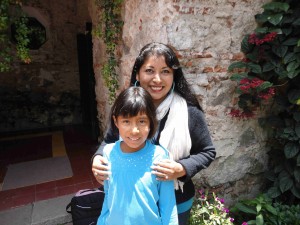 This summer at Latin American Heritage Camp, a panel of teen and adult adoptees dedicated a large percentage of their discussion to the importance of learning, speaking, and/or retaining the language of one’s birth country. The consensus was that language is critical if one wishes to interface with birth family, foster family, orphanage family, or, indeed, the culture at large, in a meaningful way. That’s true in my own life, as well: Speaking even elementary Spanish has allowed me to communicate with many more people in Guatemala than I would be able to otherwise.
This summer at Latin American Heritage Camp, a panel of teen and adult adoptees dedicated a large percentage of their discussion to the importance of learning, speaking, and/or retaining the language of one’s birth country. The consensus was that language is critical if one wishes to interface with birth family, foster family, orphanage family, or, indeed, the culture at large, in a meaningful way. That’s true in my own life, as well: Speaking even elementary Spanish has allowed me to communicate with many more people in Guatemala than I would be able to otherwise.
Not that teaching a child a second language is easy. For my husband and me, it has been anything but that. Neither of us is fluent in Spanish, which is our biggest obstacle. And not only do we not employ a nanny who speaks Spanish, we rarely, if ever, hire a babysitter. Our local public school is not bilingual, and though we have a few Spanish-speaking friends, their children prefer to speak English while playing with our kids. This year, in third grade, Olivia will study Spanish. We’re lucky that it’s the second language taught in California schools. What about the kids adopted from Nepal or Russia or Ethiopia? How do they learn to communicate with others from their homeland? (more…)



 ShareThis
ShareThis